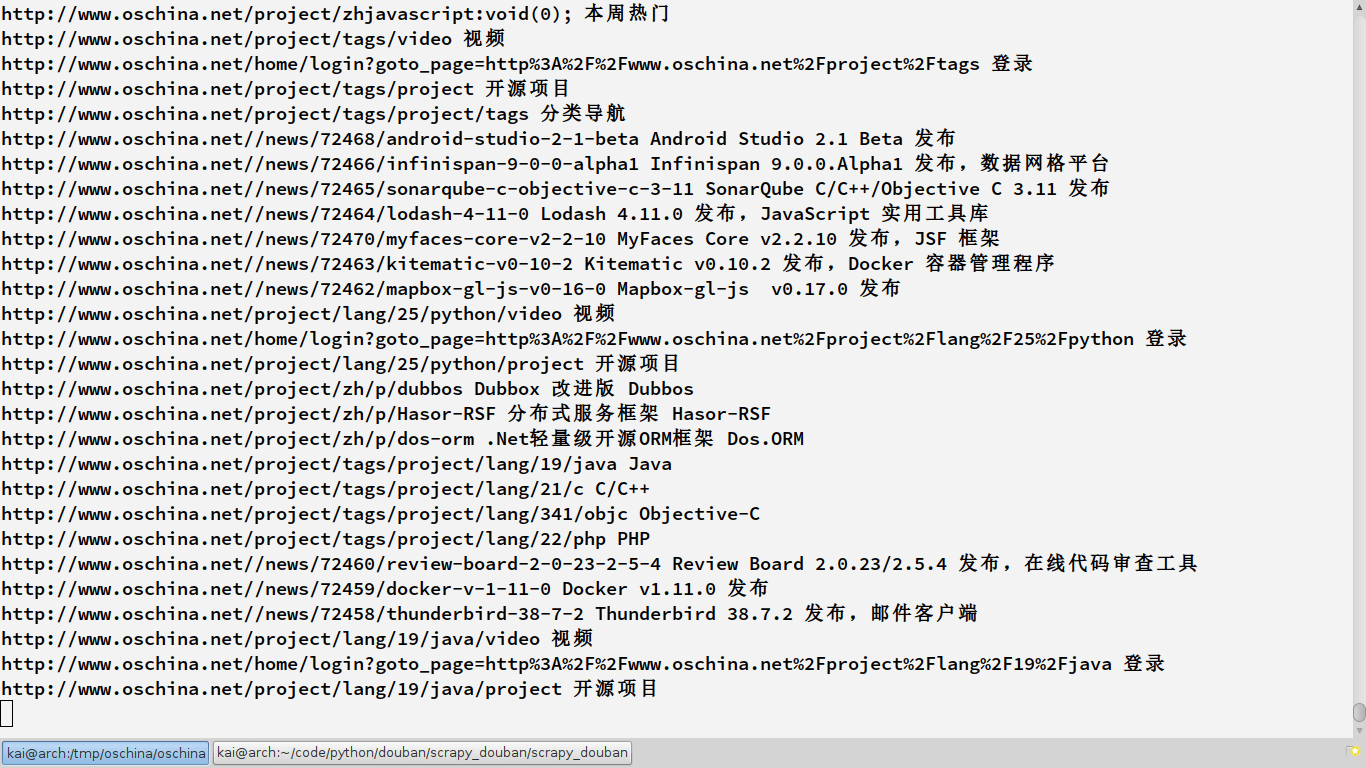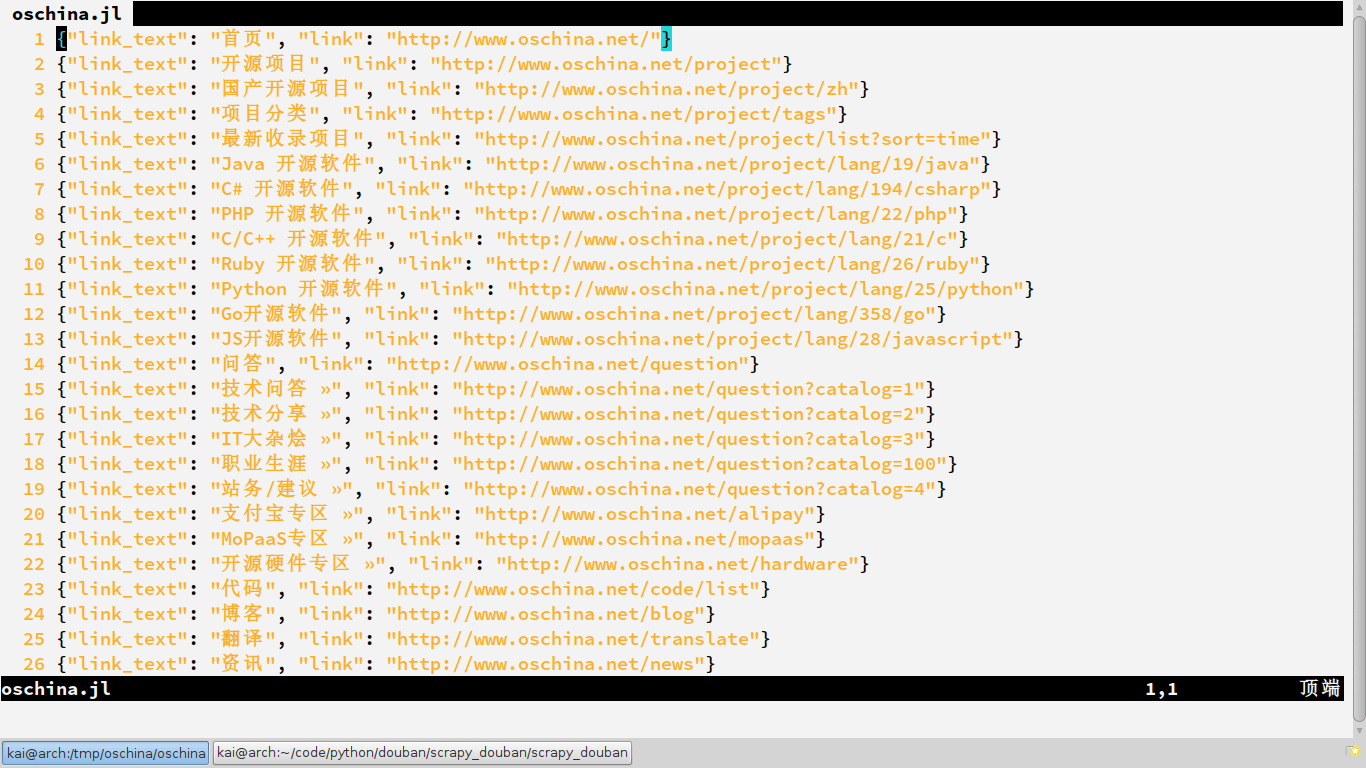python爬取全站链接
以 oschina 为例:
生成项目
$ scrapy startproject oschina
$ cd oschina
配置 编辑 settings.py, 加入以下(主要是User-agent和piplines):
USER_AGENT = 'Mozilla/5.0 (X11; Linux x86_64; rv:45.0) Gecko/20100101 Firefox/45.0'
LOG_LEVEL = 'ERROR'
RETRY_ENABLED = False
DOWNLOAD_TIMEOUT = 10
ITEM_PIPELINES = {
'oschina.pipelines.SomePipeline': 300,
}
编辑 items.py, 内容如下:
# -*- coding: utf-8 -*-
import scrapy
class OschinaItem(scrapy.Item):
Link = scrapy.Field()
LinkText = scrapy.Field()
编辑 pipelines.py, 内容如下:
# -*- coding: utf-8 -*-
import json
from scrapy.exceptions import DropItem
class OschinaPipeline(object):
def __init__(self):
self.file = open('result.jl', 'w')
self.seen = set() # 重复检测集合
def process_item(self, item, spider):
if item['link'] in self.seen:
raise DropItem('Duplicate link %s' % item['link'])
self.seen.add(item['link'])
line = json.dumps(dict(item), ensure_ascii=False) + ' '
self.file.write(line)
return item
生成模板spider然后修改:
$ scrapy genspider scrapy_oschina oschina.net # scrapy genspider 爬虫名 要爬取的域名
编辑 spiders/scrapy_oschina.py:
# -*- coding: utf-8 -*-
import scrapy
from oschina.items import OschinaItem
class ScrapyOschinaSpider(scrapy.Spider):
name = "scrapy_oschina"
allowed_domains = ["oschina.net"]
start_urls = (
'http://www.oschina.net/',
)
def parse(self, response):
sel = scrapy.Selector(response)
links_in_a_page = sel.xpath('//a[@href]') # 页面内的所有链接
for link_sel in links_in_a_page:
item = OschinaItem()
link = str(link_sel.re('href="(.*?)"')[0]) # 每一个url
if link:
if not link.startswith('http'): # 处理相对URL
link = response.url + link
yield scrapy.Request(link, callback=self.parse) # 生成新的请求, 递归回调self.parse
item['link'] = link
link_text = link_sel.xpath('text()').extract() # 每个url的链接文本, 若不存在设为None
if link_text:
item['link_text'] = str(link_text[0].encode('utf-8').strip())
else:
item['link_text'] = None
#print item['link'], # 取消注释在屏幕显示结果
#print item['link_text']
yield item
运行:
scrapy crawl scrapy_oschina
结果保存在 oschina.jl 文件中, 目的只是为了介绍怎样编写item pipeline,如果要将所有爬取的item都保存到同一个JSON文件, 需要使用 Feed exports
截图如下:


保存数据到mongoDB
在 pipelines.py中加入:
import pymongo
class MongoPipeline(object):
def __init__(self, mongo_host, mongo_port, mongo_db):
self.mongo_host = mongo_host
self.mongo_port = mongo_port
self.mongo_db = mongo_db
@classmethod
def from_crawler(cls, crawler):
return cls(
mongo_host=crawler.settings.get('MONGO_HOST'),
mongo_port=crawler.settings.get('MONGO_PORT'),
mongo_db=crawler.settings.get('MONGO_DB', 'doubandb'),
)
def open_spider(self, spider):
self.client = pymongo.MongoClient(self.mongo_host, self.mongo_port)
self.db = self.client[self.mongo_db]
def close_spider(self, spider):
self.client.close()
def process_item(self, item, spider):
collection_name = item.__class__.__name__
self.db[collection_name].insert(dict(item))
return item
在settings.py设置相应的 MONGO_HOST(默认127.0.0.1),MONGO_PORT(默认27017), MONGO_DB, MONGO_COLLECTION, ITEM_PIPELINES字典加入这个项
'scrapy_douban.pipelines.MongoPipeline':400,
数字代表优先级, 越大越低
使用 XmlItemExporter
在pipelines.py添加:
from scrapy.exporters import XmlItemExporter
from scrapy import signals
class XmlExportPipeline(object):
def __init__(self):
self.files = {}
@classmethod
def from_crawler(cls, crawler):
pipeline = cls()
crawler.signals.connect(pipeline.spider_opened, signals.spider_opened)
crawler.signals.connect(pipeline.spider_closed, signals.spider_closed)
return pipeline
def spider_opened(self, spider):
file = open('%s_urls.xml' % spider.name, 'w+b')
self.files[spider] = file
self.exporter = XmlItemExporter(file)
self.exporter.start_exporting()
def spider_closed(self, spider):
self.exporter.finish_exporting()
file = self.files.pop(spider)
file.close()
def process_item(self, item, spider):
self.exporter.export_item(item)
return item
settings.py中 ITEM_PIPELINES 添加项
'oschina.pipelines.XmlExportPipeline':500,
相关文章
- Python使用tkinter组件Label显示简单数学公式
- 内网渗透之DCOM横向移动
- 以目标为导向的语义交流的共同语言——一个课程学习框架
- python爬虫前奏【成信笔记】
- HTML 5 File API:文件拖放上传功能
- 教你快速创建 Python 虚拟环境
- pyenv 实现Python多版本自由切换
- 用 Python 对 Excel文件进行批量操作
- Python - 接入钉钉机器人
- Python - 抓取 iphone13 pro 线下店供货信息并发送到钉钉机器人,最后设置为定时任务
- crontab - 解决 mac 下通过 crontab 设置了 Python 脚本的定时任务却无法运行
- [源码解析] PyTorch分布式(5) ------ DistributedDataParallel 总述&如何使用
- Python科普系列——类与方法(上篇)
- SAP对STO的交货单执行PGI,报错 -Fld selectn for mvmt type 643 acct 400020 differs
- Spring Boot 实现通用 Auth 认证的 4 种方式
- 盘点4种使用Python批量合并同一文件夹内所有子文件夹下的Excel文件内所有Sheet数据
- OushuDB 学习经验分享(三):技术特点
- Java和Python思维方式的不同之处
- Python中日志记录新技能
- 奥比中光Gemini OpenCV—Python使用

